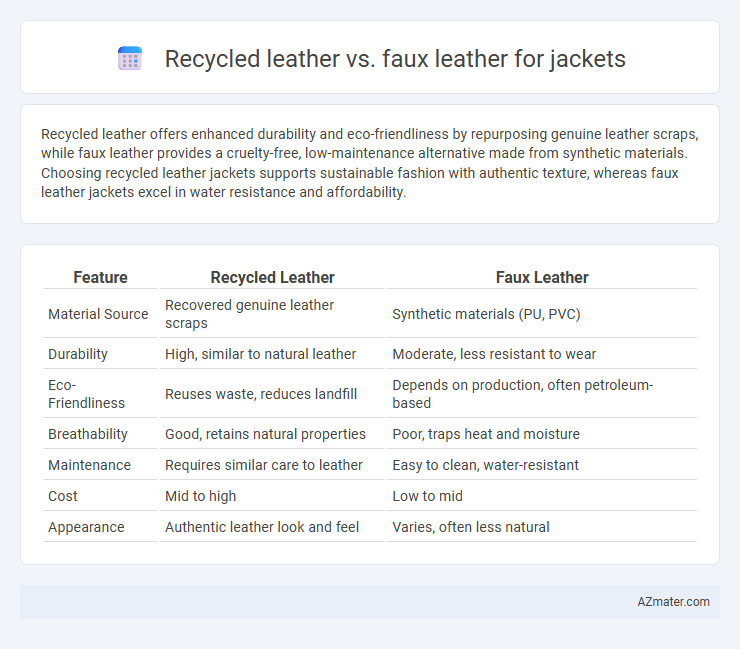Recycled leather offers enhanced durability and eco-friendliness by repurposing genuine leather scraps, while faux leather provides a cruelty-free, low-maintenance alternative made from synthetic materials. Choosing recycled leather jackets supports sustainable fashion with authentic texture, whereas faux leather jackets excel in water resistance and affordability.
Table of Comparison
| Feature | Recycled Leather | Faux Leather |
|---|---|---|
| Material Source | Recovered genuine leather scraps | Synthetic materials (PU, PVC) |
| Durability | High, similar to natural leather | Moderate, less resistant to wear |
| Eco-Friendliness | Reuses waste, reduces landfill | Depends on production, often petroleum-based |
| Breathability | Good, retains natural properties | Poor, traps heat and moisture |
| Maintenance | Requires similar care to leather | Easy to clean, water-resistant |
| Cost | Mid to high | Low to mid |
| Appearance | Authentic leather look and feel | Varies, often less natural |
Introduction: Recycled Leather vs Faux Leather
Recycled leather is crafted by reconstituting leather scraps and fibers, offering a sustainable alternative that retains the texture and durability of genuine leather. Faux leather, made from synthetic materials such as polyurethane or PVC, mimics the appearance of real leather while being entirely animal-free. Both materials present eco-friendly options for jackets, balancing style, cost, and environmental impact in distinct ways.
Material Composition and Sources
Recycled leather jackets are made from repurposed leather scraps, often combined with polyurethane or natural fibers, making them more sustainable by reducing waste from traditional leather production. In contrast, faux leather jackets consist primarily of synthetic materials like polyvinyl chloride (PVC) or polyurethane (PU), sourced from petrochemicals and designed to mimic the look and feel of genuine leather without animal products. Both materials offer eco-friendly alternatives, with recycled leather focusing on waste minimization and faux leather emphasizing animal-free sources.
Environmental Impact Comparison
Recycled leather jackets significantly reduce waste by repurposing post-consumer leather scraps, cutting down landfill contributions and minimizing the demand for new raw materials. Faux leather, typically made from synthetic polymers like polyurethane or PVC, relies on fossil fuels and generates microplastic pollution, which negatively impacts marine ecosystems. Choosing recycled leather over faux leather supports a more sustainable lifecycle with lower carbon emissions and less environmental toxicity.
Durability and Longevity
Recycled leather jackets offer enhanced durability by combining genuine leather fibers with synthetic materials, resulting in a robust fabric that resists wear and tear better than typical faux leather. Faux leather, made from PVC or polyurethane, tends to degrade faster with cracking and peeling over time, especially when exposed to frequent use and weather conditions. Investing in recycled leather provides longer-lasting performance and maintains a more authentic leather appearance compared to the synthetic alternatives.
Comfort and Wearability
Recycled leather jackets offer enhanced breathability and improved moisture absorption, resulting in superior comfort during extended wear compared to faux leather. Faux leather provides consistent flexibility and resistance to stretching, which contributes to easy movement and long-term durability. The natural texture of recycled leather often offers a softer feel, while faux leather excels in lightweight wearability and low maintenance.
Cost and Affordability
Recycled leather jackets typically cost more than faux leather due to the sustainable production process and higher durability of genuine leather fibers. Faux leather is more affordable, making it a popular choice for budget-conscious consumers seeking stylish outerwear. Buying recycled leather supports eco-friendly fashion, while faux leather offers a cost-effective alternative without compromising on leather-like appearance.
Aesthetic Appeal and Style Options
Recycled leather offers a unique, natural grain and subtle variations that enhance the jacket's authenticity and vintage charm, appealing to eco-conscious fashion enthusiasts seeking genuine leather aesthetics. Faux leather provides a wide array of colors, textures, and finishes, allowing for bold, contemporary designs and versatile styling that caters to trend-driven consumers. Both materials accommodate diverse fashion sensibilities, but recycled leather leans toward classic and rustic looks, whereas faux leather excels in modern, edgy, and experimental styles.
Maintenance and Care Requirements
Recycled leather jackets require gentle cleaning with mild soap and water to preserve their natural fibers and prevent cracking. Faux leather jackets are more water-resistant and easier to maintain, often needing only a wipe-down with a damp cloth and occasional conditioning to avoid peeling. Both materials benefit from storing in a cool, dry place away from direct sunlight to prolong their durability and appearance.
Ethical Considerations
Recycled leather jackets reduce environmental impact by repurposing waste materials and lowering the demand for new animal hides, promoting sustainability and reducing landfill contributions. Faux leather offers a cruelty-free alternative by eliminating animal exploitation but often relies on synthetic materials derived from petroleum, raising concerns about microplastic pollution and non-biodegradability. Choosing between recycled leather and faux leather involves balancing animal welfare benefits with ecological footprint, prioritizing materials that minimize harm to both animals and the environment.
Which Leather Alternative Is Best for Jackets?
Recycled leather offers a sustainable option by repurposing genuine leather scraps, providing durability and a natural texture ideal for jackets. Faux leather, made from synthetic materials like polyurethane, is typically more affordable, water-resistant, and animal-friendly but may lack the breathability and aging characteristics of recycled leather. Choosing the best leather alternative for jackets depends on prioritizing environmental impact, comfort, and long-term wear qualities.

Infographic: Recycled leather vs Faux leather for Jacket
 azmater.com
azmater.com